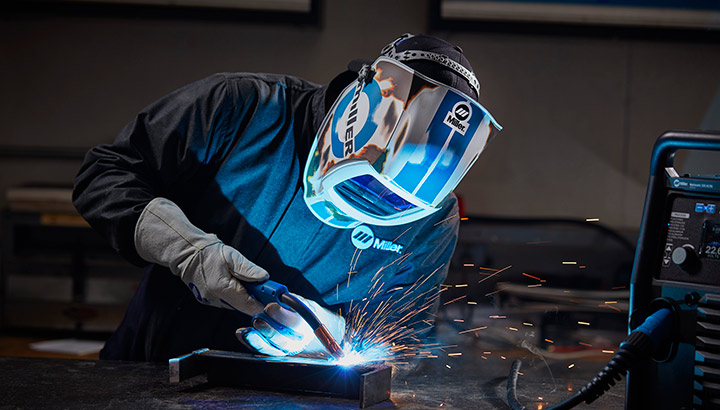If you’re looking for a new aluminium MIG welder, it’s essential to know what type of projects require this type of welding machine. There are several types of aluminium MIG welders on the market, so choosing one with the features and specifications that work best for your needs is essential.
This article will cover tips for selecting an aluminum MIG welder, including our top picks.
What Is a MIG Welder and How Does It Work?
A mig welder is one of the most popular welders in today’s industry. It uses an arc to create a joint, which can be done on metal, wood, or other materials. The advantages of this type of welding include the ability to produce clean joints with no filler material needed and minimal distortion during construction or repairs.
The basic operation of a MIG welder involves gas flow from an outlet through two electrodes (one positive and one negative) before being sent through an electrode holder at its tip. As this gas travels through your work piece, it creates heat that melts the metal enough so that when it hits your surface again after passing through another flat surface called a bushing where you want your welded seam to end up, you’ll get an excellent result!
What Type of Projects Require an Aluminum MIG Welder?
Now that you’ve learned about all the features and capabilities of a suitable aluminum MIG welder, it’s time to decide how much power is enough for your project. If you’re looking at welding aluminum pipes, then a 100-amp tool is fine. But an inverter option would suit your needs if you need something more potent than that, such as building cars or boats out of steel or aluminum (which requires higher temperatures).
If there’s one thing we can say about these welders—and there is—, it’s this: they’re versatile! They’ll work on any metal surface, whether thick plate or thin sheet metal like stainless steel and titanium parts; they also have settings built into them so that even beginners can get started immediately without having much experience beforehand!
Choosing the Right Aluminum MIG Welder
Choosing the suitable aluminum MIG welder for your needs can be daunting. You want to ensure you get one suited for aluminum, stainless steel, and copper.
The best units can handle all three types of metal, so they won’t have any issues with melting or burning up while in use. You will also want to check your unit’s flow rate and voltage output before purchasing it so you know exactly what kind of performance it has within its limits.
Another critical aspect of choosing an aluminum mig welder is finding one with low amp settings since this helps reduce stress on parts while welding them together securely without causing extra damage during operation (i
How to Properly Set Up an Aluminum MIG Welder
When you’re setting up an aluminum MIG welder, there are a few things to keep in mind:
- Voltage and wire feed speed. You’ll first want to set the voltage at either 120V or 240V for each of your welding electrodes. After that, it’s time for your wire feed speed! This setting can vary depending on what type of material you’re welding and whether or not it’s going through a spool gun (more on this later).
- Amperage. Once all this is set up correctly, it’s time for amperage! The amount of current flowing through the torch tip will determine how well your welds stick together—and if any fail during transportation back home after finishing them off at work. That’s where shielding gas comes into play:
Tips for Successful Welding with an Aluminum MIG Welder
To ensure that you are using the correct type of wire and amount, follow these tips:
- Make sure you have a good understanding of what each type of wire is capable of doing. If your aluminum welding needs are simple, like joining two pieces together without any fancy work like adding intricate curving or angle cutting, then stick with thin-gauge steel wire (0.030″). For more complicated jobs like cutting out shapes or adding complex curves and shapes, use thicker gauges (0.045″ and up).
- Be sure not to overheat when working with aluminum if this happens, there’s no going back! You’ll need more gas than usual to complete your job correctly; remember that shielding gas protects against spatter from flying off when welding aluminum at high temperatures.
Safety Precautions When Using an Aluminum MIG Welder
- Wear safety equipment. Most aluminum MIG welders have a built-in shield that protects the operator from stray sparks and flying particles. However, wearing your safety gear is still important when using an aluminum MIG welder.
- Use a welding helmet. A good helmet will protect against flying metal shrapnel and prevent burns on your face and head if something goes wrong with the machine (which is why you should never try this without one). The best thing about this type of helmet is that they come in various sizes, so they fit everyone, from small children who are learning to use one for the first time to adults with big heads who already know what they’re doing! You can even find them online if there isn’t one nearby in person – make sure whatever company sells these products have been around long enough before making purchases so as not to get scammed by counterfeit goods.”
Conclusion
We’ve given you some insight into aluminum welding and helped you find the perfect aluminum MIG welder for your needs. Remember that there are many different types of aluminum MIG welders on the market, so if this post doesn’t answer all your questions, feel free to research more!




